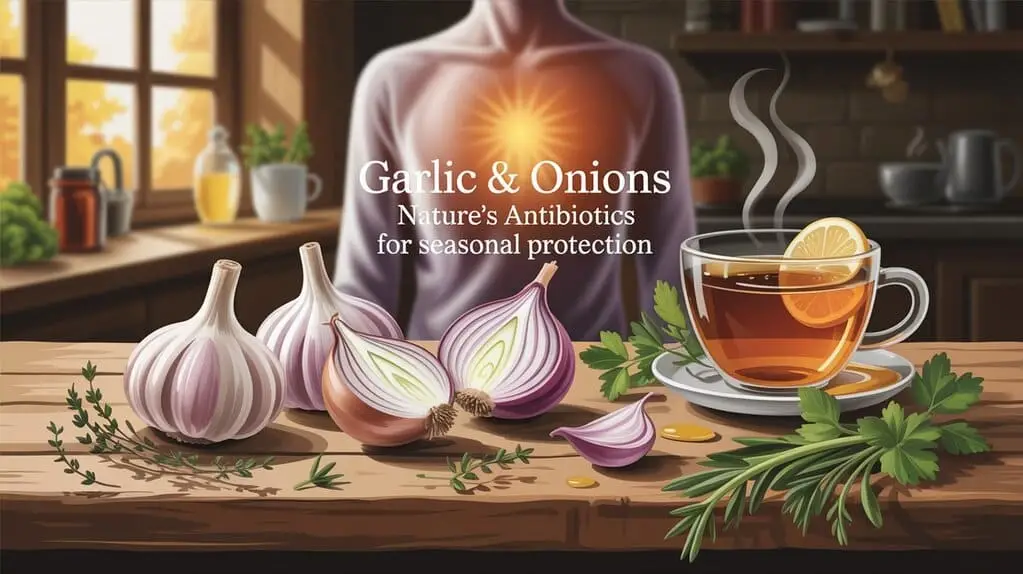
Introduction
When temperatures drop and colds start to circulate, simple dietary choices can meaningfully support digestion and immune resilience. Apples and pears are two widely available, affordable, and versatile fruits that pack fiber, vitamins, and phytochemicals that help maintain gut health, modulate inflammation, and support immune function. Both fruits are particularly useful in cold weather because they are often available fresh and in storage varieties, provide comforting texture and flavor, and deliver nutrients that help the body maintain barrier defenses and balanced microbiota during seasonal stress. This article explains how apples and pears promote digestion and immunity, highlights the most important nutrients and active compounds, offers practical consumption tips, and cites recent scientific and medical literature from Asia, America, and Europe.
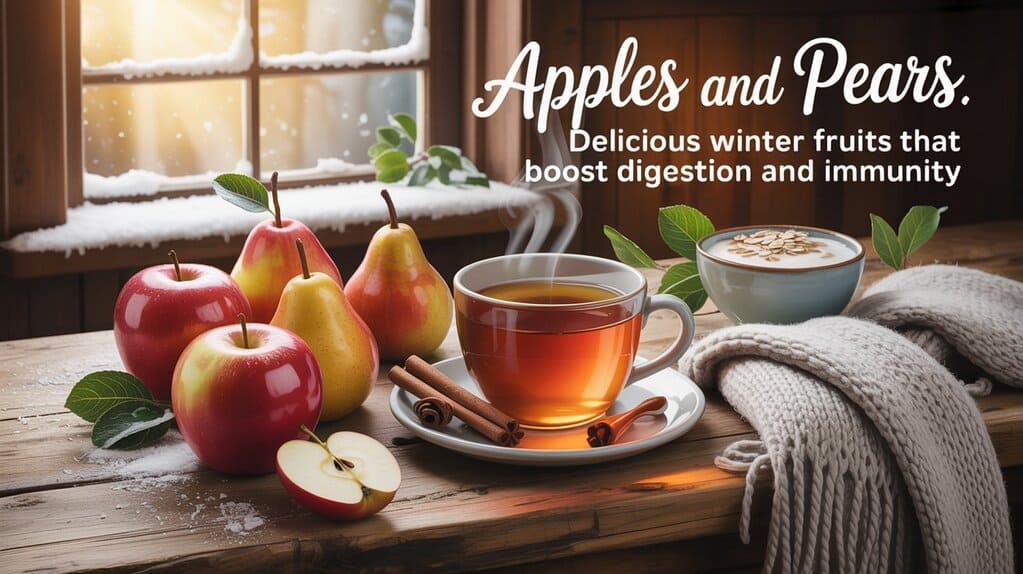
Why apples and pears matter in cold weather
Cold weather brings two practical problems for gut and immune health: (1) people tend to eat fewer fresh vegetables and fruits, lowering dietary fiber and micronutrient intake, and (2) respiratory infections and inflammatory responses rise, increasing demand for anti-inflammatory and immune-supporting nutrients. Apples and pears counter both effects: they are sources of soluble fiber (pectin), insoluble fiber, vitamin C, polyphenols (including quercetin and other flavonoids), and water — a combination that supports regular digestion, nourishes beneficial gut microbes, and supplies antioxidants that modulate immune signaling. Multiple reviews and experimental studies show that apple- and pear-derived pectins and polyphenols interact with the gut microbiota and immune system in beneficial ways. PMC+1
Nutrients and bioactive compounds: what’s inside apples and pears
Both fruits share similar basic nutrient profiles but differ in specific amounts and phytochemical composition.
Major components and actions
- Dietary fiber (pectin and cellulose): Soluble pectin forms a viscous gel that slows gastric emptying, aids stool formation, and acts as a prebiotic substrate for beneficial bacteria. Pectins also influence local immune responses in the gut. PMC+1
- Polyphenols & flavonoids (quercetin, phloridzin, catechins): These antioxidants reduce oxidative stress, downregulate inflammatory cytokines, and have direct and indirect effects on antiviral and antibacterial defenses. Quercetin, present especially in apple peel, is well studied for anti-inflammatory and immune-modulating effects. PMC+1
- Vitamin C and micronutrients: Both fruits contribute vitamin C, potassium, and small amounts of vitamins K and B, supporting general immune function and electrolyte balance. Harvard’s Nutrition Source summarizes population evidence linking apple consumption with health benefits. The Nutrition Source
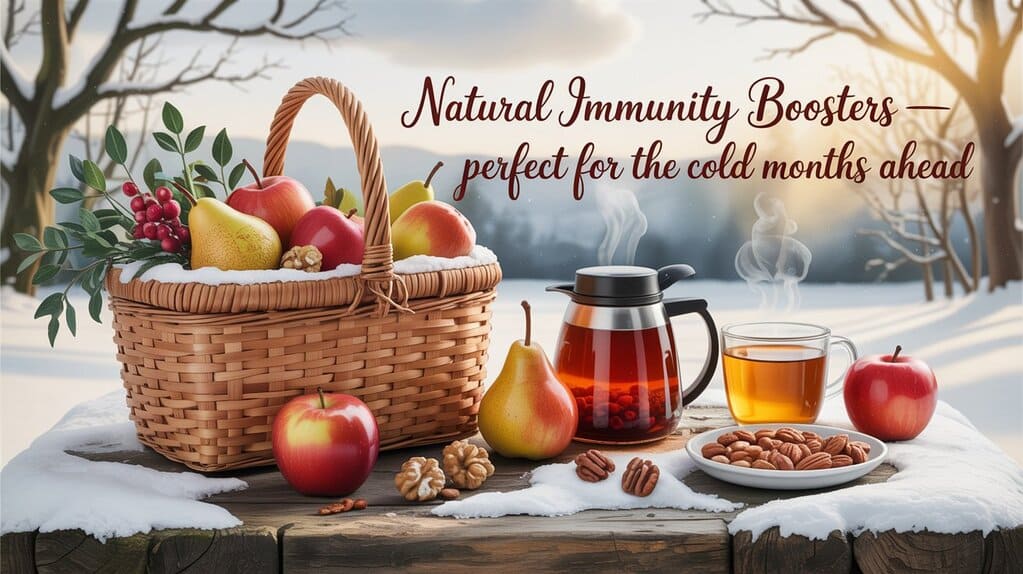
Nutrient comparison (typical medium fruit)
| Nutrient / Component | Apple (medium, with skin) | Pear (medium, with skin) |
|---|---|---|
| Calories | ~95 kcal | ~100 kcal |
| Fiber | ~4.4 g | ~5.5 g |
| Vitamin C | ~8–10 mg | ~7–8 mg |
| Water | high (~85–86%) | high (~84–85%) |
| Notable phytochemicals | Quercetin, phloridzin, catechins | Flavonols, pectins, arbutin (in some varieties) |
(Values are approximate; amounts vary by cultivar and ripeness.) The higher average fiber in pears can make them particularly effective for regularity, while apples — especially with skin — provide high levels of polyphenols concentrated near the peel. MDPI+1
How apples and pears improve digestion
- Promote bowel regularity. The soluble fiber pectin absorbs water and forms a soft gel that eases stool passage and reduces constipation risk. Several human and animal studies link apple pectin to improved bowel function and stool frequency. PMC+1
- Feed beneficial gut bacteria. Pectins and fruit-derived oligosaccharides are fermentable by commensal microbes (e.g., Bacteroides and some Firmicutes), producing short-chain fatty acids (SCFAs) such as butyrate, acetate, and propionate; SCFAs nourish colonocytes and strengthen the mucosal barrier, lowering inflammation. Recent mechanistic work confirms that dietary pectin shifts microbiota composition and modulates immune responses in the gut. Nature+1
- Soothing effect in inflammatory gut disorders. Pectins can have direct effects on the gut immune barrier (beyond microbiota) and have been shown in preclinical models to attenuate experimental colitis. This suggests potential benefits for people with mild inflammatory bowel symptoms when consumed as part of a balanced diet. Nature
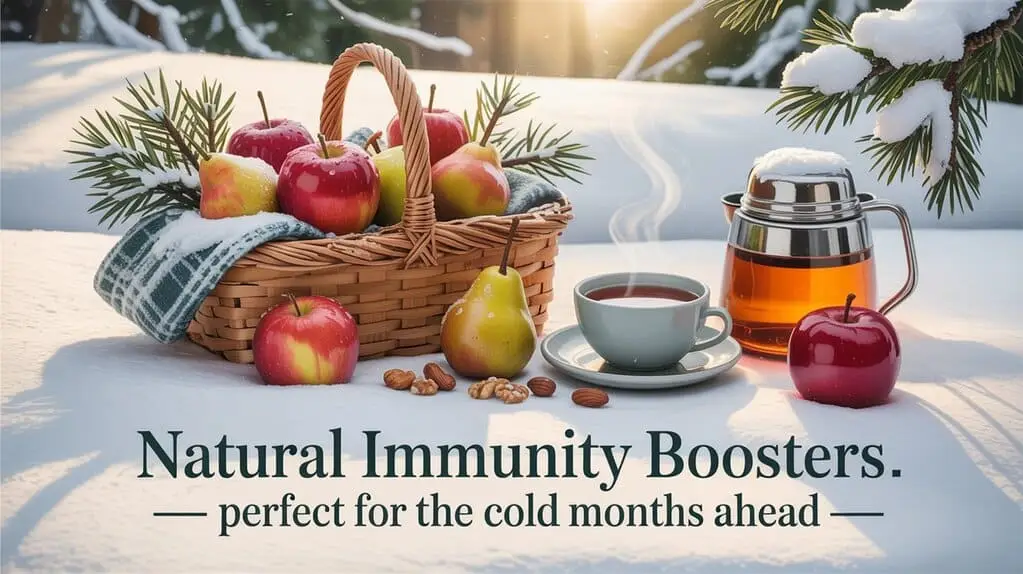
How apples and pears support immunity
- Antioxidant and anti-inflammatory actions. Polyphenols such as quercetin reduce oxidative stress and modulate cytokine production, which can temper excessive inflammation during infection and support balanced immune responses. Reviews across Asia, Europe, and North America report quercetin’s broad immunomodulatory properties. PMC+1
- Prebiotic effects linked to systemic immunity. By shaping the gut microbiome, apple and pear fibers indirectly affect systemic immunity; microbiota-derived metabolites (SCFAs) influence regulatory T cells and mucosal immunity, important in defending against respiratory infections typical in cold weather. Recent human and animal studies connect dietary fruit pectins to modulation of allergy and immune responses. PMC+1
- Synergy with micronutrients. Vitamin C supports innate immune cell function (e.g., phagocytosis), while potassium and hydration support mucus production and mucosal defenses in the respiratory and digestive tracts.
Practical tips — how to get the most benefit
- Eat the skin when possible. Many polyphenols and much of the fiber are concentrated in or under the peel. Wash well to remove residues but keep the skin on. PMC
- Choose whole fruit over juice. Whole apples and pears retain pectin and fiber that are lost in juice. Fiber slows sugar absorption and supports gut microbes. The Nutrition Source
- Combine with protein or probiotics. Pairing apples or pears with yogurt, cheese, or nut butter can enhance satiety and support a favorable gut environment; fermented dairy adds direct probiotic support.
- Warm preparations in cold weather. Baked apples or poached pears with cinnamon are comforting and still supply fiber and polyphenols; avoid heavy added sugars.
- Varietal differences matter. Different cultivars vary in polyphenol content; for example, some red apple varieties have higher total phenolics. Rotate varieties to gain a broader phytochemical exposure. MDPI
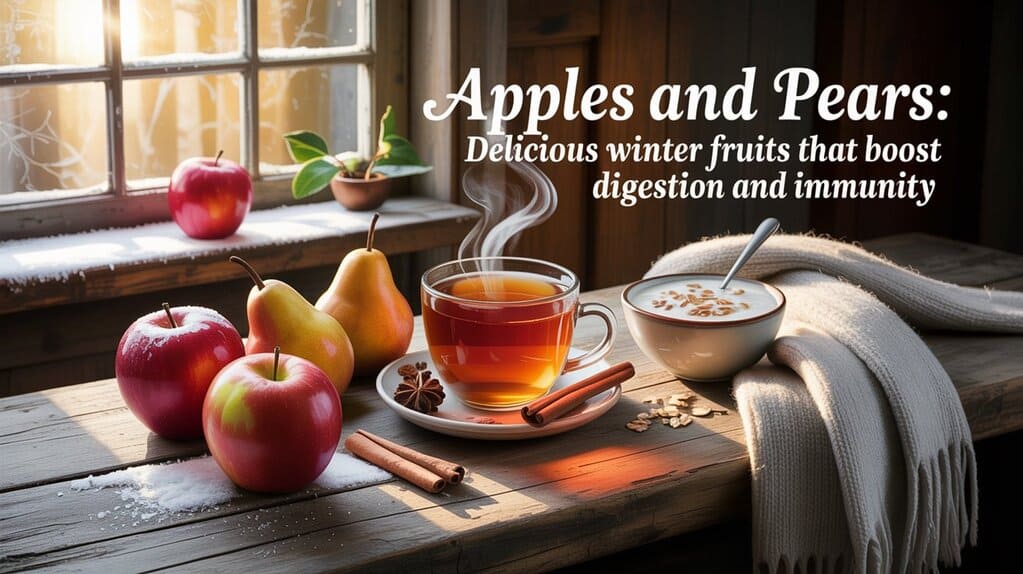
Special considerations and populations
- IBS and FODMAPs: Pears are higher in fructose and some varieties can be high-FODMAP; individuals with IBS may tolerate apples and pears differently and should test amounts slowly. Verywell Health
- Allergies: Oral allergy syndrome can occur in people allergic to birch pollen who react to raw apples or pears; cooking often reduces this risk.
- Drug interactions: High doses of flavonoid supplements could interact with certain medications; normal food amounts are generally safe.
Key points (SEO-friendly summary)
- Apples and pears are rich in dietary fiber (pectin), polyphenols (including quercetin), and vitamin C, which together support digestion and immune health. PMC+1
- Pectin acts as a prebiotic, feeding helpful gut bacteria and promoting production of SCFAs that support gut barrier and immune regulation. Nature
- Eating the whole fruit (with skin) provides more fiber and phytochemicals than juice. The Nutrition Source
- Pears generally provide slightly more fiber per fruit and can be particularly helpful for regularity; apples can be higher in certain polyphenols—both are useful in cold months. PMC+1
Conclusion
Apples and pears are delicious, versatile allies for digestive comfort and immune resilience during cold weather. Their combination of soluble fiber (pectin), polyphenols (quercetin and related flavonoids), hydration, and modest vitamin content supports regularity, feeds beneficial gut microbes, and helps modulate inflammation — all of which contribute to stronger mucosal and systemic immune defenses. Regularly including whole apples and pears (with the skin) in seasonal menus — fresh, baked, or poached — is a practical, evidence-based strategy to support gut health and immunity. For individuals with IBS, allergies, or medication concerns, personalize intake and consult a healthcare provider. Overall, the scientific literature from Europe, North America, and Asia converges: apples and pears are an accessible, evidence-supported part of a gut- and immune-supporting diet. PMC+2PMC+2
References (selected)
- Blanco-Pérez F, et al. The Dietary Fiber Pectin: Health Benefits and Potential for… (review). 2021. PubMed Central. PMC
- Mirza MA, et al. Quercetin as a Therapeutic Product: Evaluation of Its… 2023. PubMed Central. PMC
- Steigerwald H, et al. Dietary fiber pectin alters the gut microbiota and diminishes … Nature Scientific Reports. 2024. Nature
- Reiland H, et al. Systematic Review of Pears and Health. 2015. PubMed Central. PMC
- Harvard T.H. Chan School of Public Health. Apples — The Nutrition Source. (summary of evidence). The Nutrition Source
- Boyer J, Liu RH. Apple phytochemicals and their health benefits. 2004. PubMed Central. PMC
- Mierczak K., et al. Overview of Apple Varieties and the Importance… MDPI Nutrients. 2024. MDPI
- Pérez-Cano FJ, et al. Flavonoids, Inflammation and Immune System. 2016. PubMed Central. PMC

